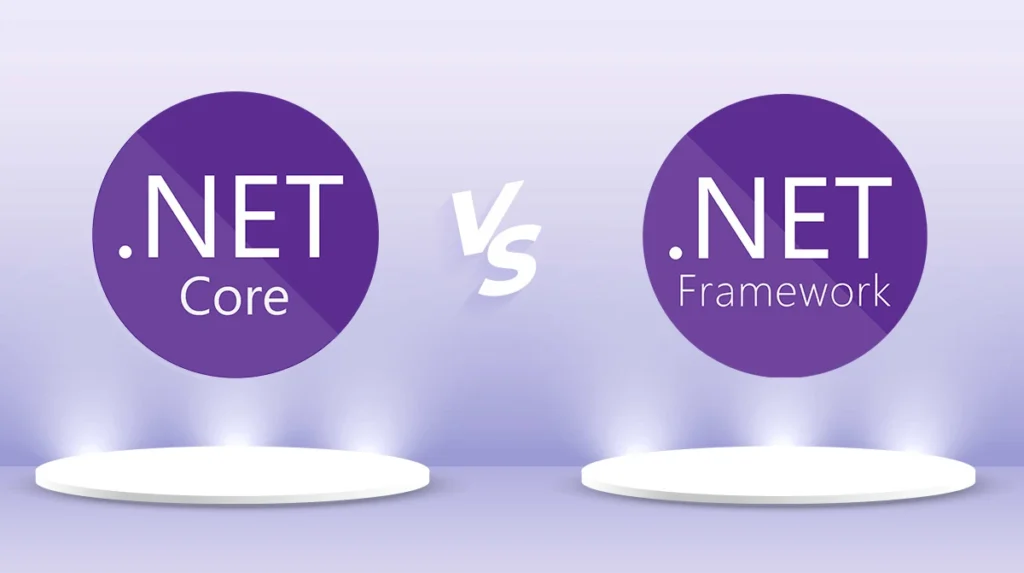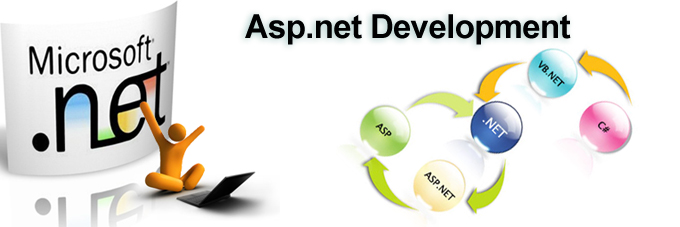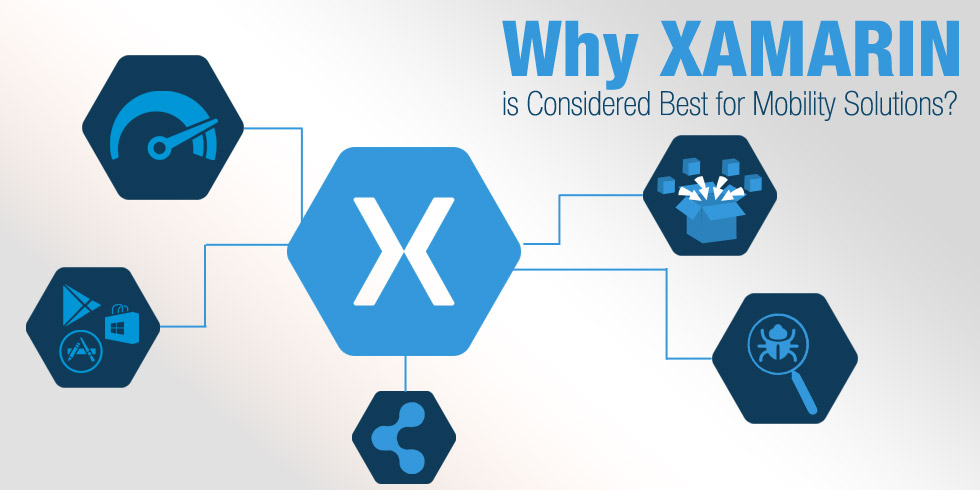Selecting the right development platform is crucial for businesses looking to build, modernize, or scale their applications. Microsoft’s .NET ecosystem provides two primary frameworks: .NET Core and .NET Framework. While both serve as robust foundations for application development, they cater to different business needs and technological scenarios.
This blog explores the key differences, advantages, limitations, and migration strategies between .NET Core and .NET Framework.
What is .NET Core?
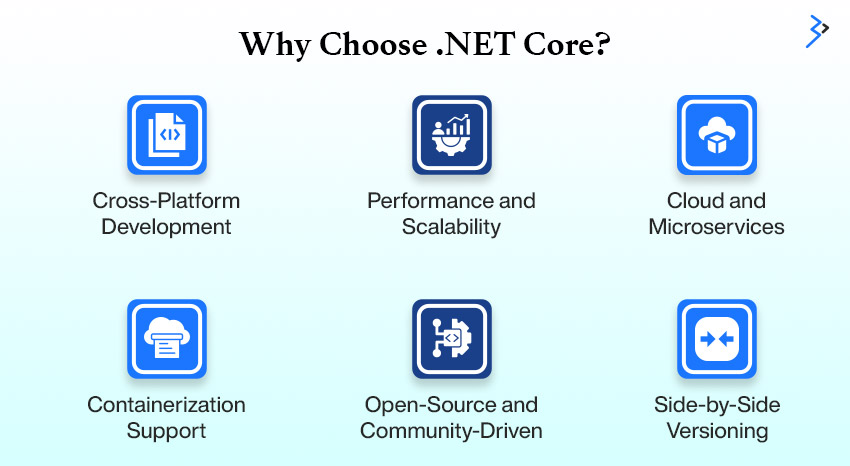
.NET Core is an open-source, cross-platform framework designed for modern application development. It is modular, lightweight, and optimized for cloud-based and containerized applications. Initially released in 2016, .NET Core was developed to address limitations in the .NET Framework and support evolving business needs.
Key Features:
- Build and launch apps on different OSes, increasing deployment flexibility, including cross-platform capabilities.
- To reduce the total footprint and improve performance, developers can use a lightweight, modular approach to incorporate only the components needed for their application.
- Web, mobile, desktop, cloud, Internet of Things, and gaming apps may all be built using the same .NET Core runtime, which promotes a uniform development experience.
- Much faster than the .NET Framework, particularly regarding cloud-based apps and microservices.
- An engaged developer community supports .NET Core on GitHub, allowing quick updates and enhancements.

When to Choose .NET Core
.NET Core is ideal for businesses building modern, high-performance, scalable applications. Choose .NET Core if:
- You are developing cloud-native applications
- You want high performance and scalability
- You are adopting a microservices architecture
What is .NET Framework?
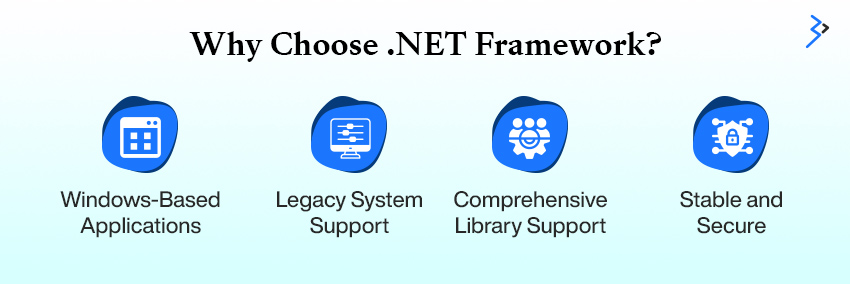
.NET Framework is a mature, Windows-only platform introduced in 2002. It provides a comprehensive environment for building and running applications on Windows operating systems. The framework includes a vast library set and supports legacy applications, making it a preferred choice for enterprises heavily invested in Windows-based infrastructure.
Key Features:
- The CLR, or Common Language Runtime, is a part of the virtual machine that controls program execution, memory allocation, and more.
- The Base Class Library (BCL) is an extensive set of reusable classes, interfaces, and value types that developers may use to make their work easier and faster.
- The Active Server Pages (ASP.NET Core Development) framework is an online application, web service, and website builder.
- Windows Presentation Foundation (WPF) and Windows Forms are frameworks for creating graphical user interfaces for desktop applications.
- Interoperability is the ability for .NET Framework code to communicate with other technologies, such as COM (Component Object Model) components and third-party DLLs.
Read More – The Advantages of Using .NET Core for Software Development
When to Choose .NET Framework
.NET Framework remains a strong choice for businesses with existing Windows-based applications. Choose .NET Framework if:
- Your application relies on Windows-specific services
- You have legacy applications built on .NET Framework
- You need to use older technologies like Web Forms or WCF
Key Differences Between .NET Core and .NET Framework
| Feature | .NET Core | .NET Framework |
| Platform Compatibility | Cross-platform (Windows, macOS, Linux) | Windows-only |
| Performance | High performance with optimized runtime | Slower in comparison |
| Microservices Support | Fully supports microservices and containers | Limited support |
| Deployment | Self-contained and side-by-side versioning | Centralized versioning with Windows |
| Application Types | Cloud applications, IoT, microservices, high-performance applications | Legacy enterprise applications, Windows Forms, WPF |
| Open Source | Fully open-source | Partially open-source |
| Support & Updates | Actively developed with new updates | Limited future updates |
Advantages and Use Cases
Businesses seeking a reliable, efficient, scalable technology stack often turn to Microsoft’s .NET ecosystem. Whether opting for .NET Core or .NET Framework, organizations can leverage their strengths based on project requirements, infrastructure, and future goals. Understanding their unique advantages and use cases helps in making an informed decision.
Why Choose .NET Core?
.NET Core is a modern, open-source, cross-platform framework for high-performance applications. Its flexibility, efficiency, and scalability have gained traction among developers and enterprises. Below are some compelling reasons to choose .NET Core:
1. Cross-Platform Development
Businesses targeting multiple operating systems benefit from .NET Core’s cross-platform capabilities. Applications built on .NET Core can run seamlessly on Windows, macOS, and Linux, making it an ideal choice for organizations with diverse IT ecosystems.
Use Cases:
- Cross-platform web applications
- Mobile backend services
- Enterprise applications requiring OS flexibility
2. Performance and Scalability
.NET Core delivers superior performance thanks to its modular design and optimized runtime. It allows developers to build high-performing applications that scale efficiently, making it suitable for businesses with demanding workloads.
Use Cases:
- Real-time financial applications
- High-traffic web platforms
- Performance-critical APIs
3. Cloud and Microservices
With cloud-native applications becoming the industry standard, .NET Core excels in supporting microservices architecture. It integrates seamlessly with Microsoft Azure, AWS, and Google Cloud.
Use Cases:
- Cloud-based SaaS applications
- Scalable microservices architecture
- Serverless computing solutions
4. Containerization Support
.NET Core is optimized for containerization, working seamlessly with Docker and Kubernetes. This enables developers to deploy applications efficiently, ensuring consistency across different environments.
Use Cases:
- Containerized applications
- DevOps automation and CI/CD pipelines
- Cloud-native microservices deployment
5. Open-Source and Community-Driven
Being open-source, .NET Core benefits from continuous improvements by a vibrant developer community. Regular updates and contributions enhance security, stability, and feature-richness.
Use Cases:
- Agile development teams looking for open-source solutions
- Startups leveraging cost-effective development
- Organizations seeking innovation through community-driven enhancements
6. Side-by-Side Versioning
.NET Core enables multiple versions to run on the same system, preventing dependency conflicts and facilitating smooth updates.
Use Cases:
- Organizations maintain multiple projects with different dependencies
- Enterprises migrating applications while retaining legacy versions
.Net is Ideal For:
- Cloud applications
- Scalable microservices
- High-performance applications
Read More – Top 10 Reasons to Migrate from .NET Framework to .NET Core
Why Choose .NET Framework?
While .NET Core is the preferred choice for new applications, .NET Framework remains relevant for organizations with existing Windows-based applications. It provides stability, long-term enterprise support, and robust legacy system integration.
1. Windows-Based Applications
For enterprises deeply integrated into the Windows ecosystem, .NET Framework remains the best choice. It ensures seamless compatibility with Windows-specific features and services such as Active Directory and WCF (Windows Communication Foundation).
Use Cases:
- Internal business applications
- Desktop software for Windows users
- Applications requiring deep Windows OS integration
2. Legacy System Support
.NET Framework is essential for maintaining and upgrading older applications built on previous versions of .NET. Organizations with established systems benefit from its stable and mature infrastructure.
Use Cases:
- Enterprise applications that cannot be migrated
- Businesses relying on legacy software with complex dependencies
- Companies needing gradual modernization
3. Comprehensive Library Support
.NET Framework has extensive built-in libraries, third-party integrations, and a robust ecosystem that simplifies development.
Use Cases:
- Enterprise-grade applications with extensive dependencies
- Large-scale business software requires a wide range of functionalities
- Development teams reliant on mature .NET libraries
4. Stable and Secure
Being a well-established framework, .NET Framework offers a high level of security and long-term support from Microsoft, making it ideal for mission-critical applications.
Use Cases:
- Government and financial institutions require strict security measures
- Enterprises prioritizing long-term framework support
- Applications requiring compliance with stringent regulations
.NET Framework is Ideal For:
- Enterprise-grade applications
- Legacy system maintenance
- Windows-based business solutions
Migration Strategies: Moving from .NET Framework to .NET Core
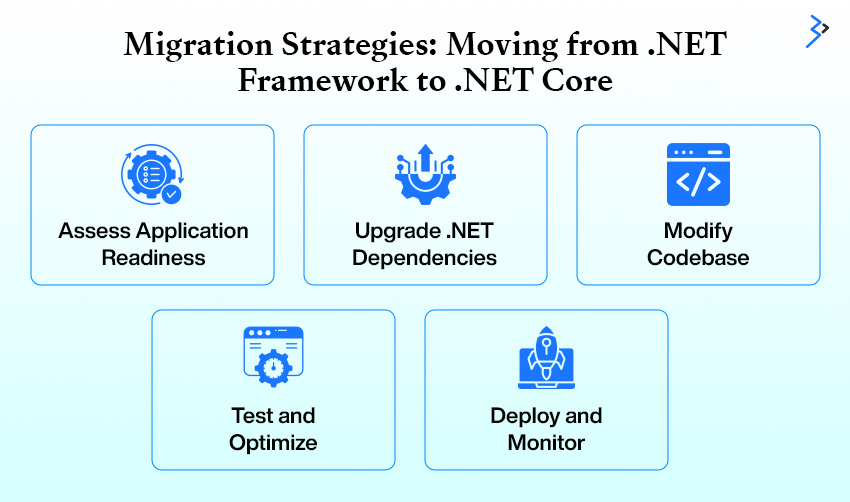
Many organizations are transitioning from .NET Framework to .NET Core to take advantage of modern features, enhanced performance, and cross-platform capabilities. However, a successful migration requires a well-planned approach to mitigate risks and maximize benefits.
Steps for Migration
1. Assess Application Readiness
Before starting the migration, conduct a thorough assessment of the existing application. Identify dependencies, compatibility issues, and Windows-specific components that need modification. Use tools like .NET Upgrade Assistant to analyze feasibility.
2. Upgrade .NET Dependencies
Many libraries in .NET Framework may not be directly compatible with .NET Core. Replace outdated libraries with .NET Standard or .NET Core-compatible versions. If necessary, find alternative packages that offer similar functionality.
3. Modify Codebase
Refactor platform-dependent code, such as Windows Registry access, WCF (Windows Communication Foundation), or System.Drawing-based UI components. Update configurations, authentication mechanisms, and logging frameworks to align with .NET Core’s modular architecture.
4. Test and Optimize
Perform comprehensive testing to ensure stability and performance after migration. Utilize automated testing frameworks to identify regressions, optimize database queries, and improve memory management.
5. Deploy and Monitor
Deploy the migrated application using cloud-native approaches or containerized environments like Docker and Kubernetes. Implement monitoring tools to track performance, detect errors, and enhance reliability.
Challenges in Migration
1. Compatibility Issues
Certain legacy features and third-party libraries may not be supported in .NET Core. Developers need to find workarounds or rewrite functionalities to ensure seamless integration.
2. Resource Investment
Migration requires significant time, effort, and financial investment. Organizations must allocate development, testing, and deployment resources to ensure a smooth transition.
3. Learning Curve
.NET Core introduces concepts such as dependency injection, modular configurations, and middleware-based architectures. Developers may require training and upskilling to adapt effectively.
Migrating from .NET Framework to .NET Core offers substantial benefits but demands a strategic approach.
Future of .NET: .NET 5, 6, and Beyond
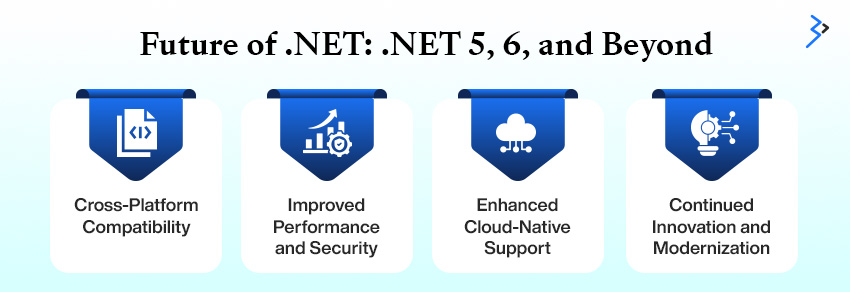
Microsoft has unified .NET Core and .NET Framework into a single, modern platform with .NET 5, .NET 6, and beyond. This evolution brings significant advancements that enhance development efficiency, scalability, and security. Businesses and developers can now leverage a unified framework that supports various application types and platforms.
1. Cross-Platform Compatibility
One of the new .NET ecosystem’s most significant advantages is its ability to run seamlessly across Windows, macOS, and Linux. Developers can build applications for multiple operating systems without requiring platform-specific modifications.
Impact:
- Enables broader market reach
- Simplifies development for diverse environments
- Reduces dependency on Windows-exclusive technologies
2. Improved Performance and Security
Each new .NET release introduces optimizations that enhance execution speed and efficiency. The Just-In-Time (JIT) and Ahead-Of-Time (AOT) compilation techniques improve runtime performance. At the same time, built-in security features like improved memory management and enhanced encryption protocols provide robust protection.
Impact:
- Faster execution of applications
- Reduced memory footprint
- Stronger security against vulnerabilities
3. Enhanced Cloud-Native Support
.NET 5 and later versions are optimized for cloud-based and microservices architectures. Native integration with Kubernetes, Docker, and Azure services makes it easier for businesses to deploy and scale applications in cloud environments.
Impact:
- Simplified cloud deployments
- Better microservices orchestration
- Reduced operational overhead
4. Continued Innovation and Modernization
Microsoft has committed to continuous innovation within the .NET ecosystem. With long-term support (LTS) versions like .NET 6 and .NET 8, developers can access new features, improved APIs, and regular security updates.
Impact:
- Future-proof application development
- Access to the latest development tools and libraries
- Enhanced support for AI, ML, and IoT applications
Conclusion
For businesses evaluating their technology stack, the choice between .NET Core and .NET Framework depends on project needs and long-term goals.
- Choose .NET Core if you require a modern, high-performance, scalable, and cross-platform solution.
- Stick with .NET Framework if you maintain legacy applications or operate within a Windows-centric environment.
Enterprises looking to future-proof their applications should consider migrating to .NET Core and embracing newer .NET versions. This transition offers greater flexibility, enhanced efficiency, and long-term modernization benefits. Organizations can make informed decisions that align with technological advancements and market demands by carefully assessing business needs.
Related Articles
-
ASP.NET or PHP: Which One Is A Better Choice For Programming?
There is no doubt that ASP.Net and PHP are the most important and most popular web programming languages used for building robust and dynamic web applications and websites. Both these
-
How Microsoft’s Xamarin Platform Helps in App Development?
Xamarin is a productive tool utilized for cross-platform mobile application development that enables software developers to share around 90 percent of code crosswise over platforms of paramount importance. Xamarin being
-
Can We Consider .NET Core as the Future of .NET: Let’s Find Out a Viable Answer to the Question
Before we answer the above question in a yes or no, let’s first provide a brief introduction to .NET Core. .NET Core is defined as an open-source and free computer

